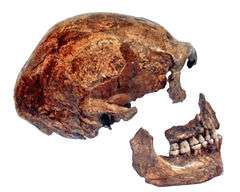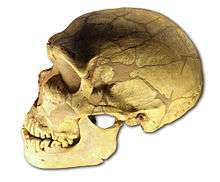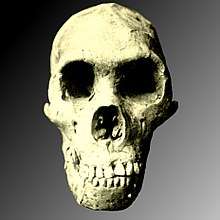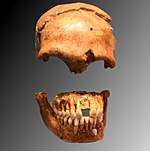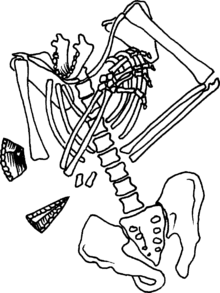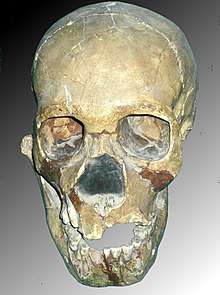Neanderthal
| Neanderthal | |
|---|---|
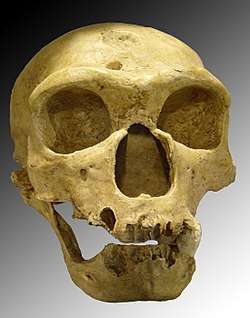 | |
| Late Neanderthal skull (La Chapelle-aux-Saints 1) | |
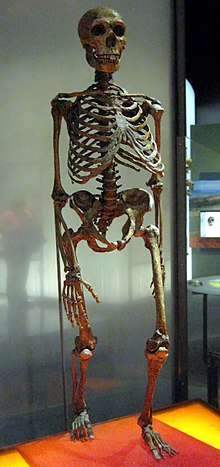 | |
| An approximate reconstruction of a Neanderthal skeleton (The central ribcage, including the sternum, and parts of the pelvis are from modern humans.) | |
| Scientific classification | |
| Kingdom: | Animalia |
| Phylum: | Chordata |
| Class: | Mammalia |
| Order: | Primates |
| Suborder: | Haplorhini |
| Infraorder: | Simiiformes |
| Family: | Hominidae |
| Subfamily: | Homininae |
| Tribe: | Hominini |
| Genus: | Homo |
| Species: | H. neanderthalensis |
| Binomial name | |
| Homo neanderthalensis King, 1864 | |
 | |
| Known Neanderthal range in Europe (blue), Southwest Asia (orange), Uzbekistan (green), and the Altai mountains (violet). | |
| Synonyms | |
|
Homo stupidus (Haeckel 1866)[1] | |
Neanderthals (UK: /niˈændərˌtɑːl/, also US: /neɪ-,
Currently earliest fossils of Neanderthals in Europe are dated between 430,000 to 450,000 years ago, and thereafter Neanderthals expanded into Southwest and Central Asia. They are known from numerous fossils, as well as stone tool assemblages. Almost all assemblages younger than 160,000 years are of the so-called Mousterian techno-complex, which is characterised by tools made out of stone flakes.[10] The type specimen is Neanderthal 1, found in Neander Valley in the German Rhineland, in 1856.
Compared to modern humans, Neanderthals were stockier, with shorter legs and bigger bodies. In conformance with Bergmann's rule, this likely was an adaptation to preserve heat in cold climates. Male and female Neanderthals had cranial capacities averaging 1,600 cm3 (98 cu in) and 1,300 cm3 (79 cu in), respectively,[11] within the range of the values for anatomically modern humans.[12] Males stood 164 to 168 cm (65 to 66 in) and females 152 to 156 cm (60 to 61 in) tall.[13]
Since 2010, there has been growing evidence for admixture between Neanderthals and anatomically modern humans. This admixture is reflected in the genomes of modern European and Asian populations, but not in the genomes of most sub-Saharan Africans. This suggests that interbreeding between Neanderthals and anatomically modern humans took place after the recent "out of Africa" migration, likely between 60,000 and 40,000 years ago.[14]
Name and classification
Neanderthals are named after one of the first sites where their fossils were discovered in the mid-19th century in the Neander Valley, just east of Düsseldorf, at the time in the Rhine Province of the Kingdom of Prussia (now in Northrhine-Westphalia, Germany). The valley itself was named for Joachim Neander, Neander being the graecicized form of the surname Neumann ("new man").[15] The German spelling of Thal "Valley" was current in the 19th century (contemporary German Tal).[lower-alpha 1][1]
Neanderthal 1 was known as the "Neanderthal cranium" or "Neanderthal skull" in anthropological literature, and the individual reconstructed on the basis of the skull was occasionally called "the Neanderthal man".[16] The binomial name Homo neanderthalensis—extending the name "Neanderthal man" from the individual type specimen to the entire group—was first proposed by the Anglo-Irish geologist William King in 1864, although that same year King changed his mind and thought that the Neanderthal fossil was distinct enough from humans to warrant a separate species.[17] King's name had priority over the proposal put forward in 1866 by Ernst Haeckel, Homo stupidus.[1] Popular English usage of "Neanderthal" as shorthand for "Neanderthal man", as in "the Neanderthals" or "a Neanderthal", emerged in the popular literature of the 1920s.[18]
Since the historical spelling -th- in German represents the phoneme /t/ or /tʰ/, not the fricative /θ/, standard British pronunciation of "Neanderthal" is with /t/ (IPA: /niːˈændərtɑːl/).[19][20][21][22] Because of the usual sound of the digraph ⟨th⟩ in English, "Neanderthal" is also pronounced with the voiceless fricative /θ/, at least in "layman's American English" (as /niːˈændərθɔːl/).[23]
The spelling Neandertal is occasionally seen in English, even in scientific publications. Since "Neanderthal", or "Neandertal", is a common name, there is no authoritative prescription on its spelling, unlike the spelling of the binominal name H. neanderthalensis, which is predicated by King 1864.[24] The common name in German is always invariably Neandertaler (lit. "of the valley of Neander"), not Neandertal, but the spelling of the name of the Neander Valley itself (Neandertal vs. Neanderthal) has been affected by the species name, the names of the Neanderthal Museum and of Neanderthal station persisting with pre-1900 orthography.[25]

(in Cleveland Museum of Natural History)
Features compared are the braincase shape, forehead, browridge, nasal bone, projection, cheek bone angulation, chin and occipital contour.
Ever since the discovery of the Neanderthal fossils, expert opinion has been divided as to whether Neanderthals should be considered a separate species (Homo neanderthalensis) or a subspecies (Homo sapiens neanderthalensis) relative to modern humans.[26][27][28] Pääbo (2014) described such "taxonomic wars" as unresolveable in principle, "since there is no definition of species perfectly describing the case."[5] The question depends on the definition of Homo sapiens as a chronospecies, which has also been in flux throughout the 20th century. Authorities preferring classification of Neanderthals as subspecies have introduced the subspecies name Homo sapiens sapiens for the anatomically modern Cro-Magnon population which lived in Europe at the same time as Neanderthals, while authorities preferring classification as separate species use Homo sapiens as equivalent to "anatomically modern humans".
During the early 20th century, a prevailing view of Neanderthals as "simian", influenced by Arthur Keith and Marcellin Boule,[29] tended to exaggerate the anatomical differences between Neanderthals and Cro Magnon. Beginning in the 1930s, revised reconstructions of Neanderthals increasingly emphasized the similarity rather than differences from modern humans. From the 1940s throughout the 1970s, it was increasingly common to use the subspecies classification of Homo sapiens neanderthalensis vs. Homo sapiens sapiens.[30] The hypothesis of "multiregional origin" of modern man was formulated in the 1980s on such grounds, arguing for the presence of an unbroken succession of fossil sites in both Europe and Asia.[31] Hybridization between Neanderthals and Cro Magnon had been suggested on skeletal and craniological grounds since the early 20th century, and found increasing support in the later 20th century,[32] until Neanderthal admixture was found to be present in modern populations genetics in the 2010s.
Evolution
Both Neanderthals and anatomically modern humans were initially thought to have evolved from Homo erectus between 300,000 and 200,000 years ago. H. erectus had emerged around 1.8 million years ago, and had long been present, in various subspecies throughout Eurasia.
The divergence time between the Neanderthal and archaic Homo sapiens lineages is estimated at between 800,000 and 400,000 years ago. The more recent time depth has been suggested by Endicott et al. (2010)[33] and Rieux et al. (2014).[34]
The time of divergence between archaic Homo sapiens and ancestors of Neanderthals and Denisovans caused by a population bottleneck of the latter was dated at 744,000 years ago, combined with repeated early admixture events and Denisovans diverging from Neanderthals 300 generations after their split from Homo sapiens, was calculated by Rogers et al. (2017).[35][36]
Homo heidelbergensis, dated 600,000 to 300,000 years ago, has long been thought to be a likely candidate for the last common ancestor of the Neanderthal and modern human lineages. However, genetic evidence from the Sima de los Huesos fossils published in 2016 seems to suggest that H. heidelbergensis in its entirety should be included in the Neanderthal lineage, as "pre-Neanderthal" or "early Neanderthal", while the divergence time between the Neanderthal and modern lineages has been pushed back to before the emergence of H. heidelbergensis, to about 600,000 to 800,000 years ago, the approximate age of Homo antecessor.[37]
The taxonomic distinctions between H. heidelbergensis and Neanderthals is mostly due to a fossil gap in Europe between 300,000 and 243,000 years ago (MIS 8). "Neanderthals", by conventions, are fossils which date to after this gap.[38][39] The quality of the fossil record greatly increases from 130,000 years ago onwards.[40] Specimens younger than this date make up the bulk of known Neanderthal skeletons and were the first whose anatomy was comprehensively studied.[41][42] In morphological studies, the term "classic Neanderthal" may be used in a narrower sense for Neanderthals younger than 71,000 years old (MIS 4 and 3).[38]
Habitat and range

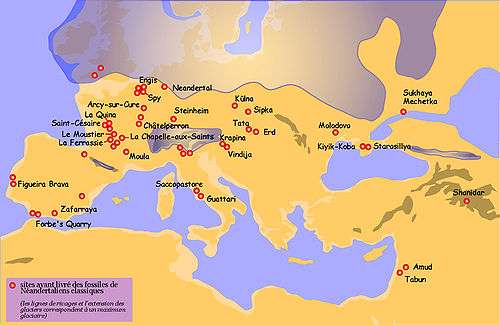
Early Neanderthals, living before the Eemian interglacial (130 ka), are poorly known and come mostly from European sites. From 130 ka onwards, the quality of the fossil record increases dramatically. From then on, Neanderthal remains are found in Western, Central, Eastern, and Mediterranean Europe,[43] as well as Southwest, Central, and Northern Asia up to the Altai Mountains in Siberia. No Neanderthal has ever been found outside Central to Western Eurasia, namely neither to the south of 30°N (Shuqba, Levant), nor east of 85°E (Denisova, Siberia).
The limit of their northern range appears to have been south of 53°N (Bontnewydd, Wales),[44] although it is difficult to assess because glacial advances destroy most human remains, the Bontnewydd tooth being exceptional. Middle Palaeolithic artifacts have been found up to 60°N on the Russian plains.[45]
Total Neanderthal effective population size has been estimated at close to 15,000 individuals (corresponding to a total population of roughly 150,000 individuals), living in small, isolated, inbred groups.[46]
Anatomy

Neanderthal anatomy differed from modern humans in that they had a more robust build and distinctive morphological features, especially on the cranium, which gradually accumulated more derived aspects as it was described by Marcellin Boule,[47] particularly in certain isolated geographic regions. These include shorter limb proportions, a wider, barrel-shaped rib cage, a reduced chin, sloping forehead, and a large nose, being at the modern human higher end in both width and length,[lower-alpha 2] and started somewhat higher on the face than in modern humans and a characteristic occipital bun.[39] Evidence suggests they were much stronger than modern humans, with particularly strong arms and hands, while they were comparable in height; based on 45 long bones from at most 14 males and 7 females, Neanderthal males averaged 164 to 168 cm (65 to 66 in) and females 152 to 156 cm (60 to 61 in) tall.[13] Samples of 26 specimens in 2010 found an average weight of 77.6 kg (171 lb) for males and 66.4 kg (146 lb) for females.[48] A 2007 genetic study suggested some Neanderthals may have had red hair and blond hair, along with a light skin tone.[49]
Gregory Cochran and Henry Harpending, in the book The 10,000 Year Explosion, investigated whether it is accurate to depict Neanderthals as having hair patterns similar to anatomically modern humans. They concluded that:
| “ | We don't yet know for sure, but it seems likely that, as part of their adaptation to cold, Neanderthals were furry. Chimpanzees have ridges on their finger bones that stem from the way that they clutch their mothers' fur as infants. Modern humans don't have these ridges, but Neanderthals do.[50] | ” |
In 2017, researchers using 3D reconstructions of nasal cavities and Computational Fluid Dynamics techniques have found that Neanderthals and modern humans both adapted their noses (independently and in a convergent way) to help breathe in cold and dry conditions.[51] The large nose seen in Neanderthals, as well as Homo heidelbergensis, affected the shape of the skull and the muscle attachments, and gave them a weaker bite force than in modern humans.[52]
In The Spread of Modern Humans in Europe (2002) John F. Hoffecker writes:
| “ | Neanderthal sites show no evidence of tools for making tailored clothing. There are only hide scrapers, which might have been used to make blankets or ponchos. This is in contrast to Upper Paleolithic (modern human) sites, which have an abundance of eyed bone needles and bone awls. Moreover, microwear analysis of Neanderthal hide scrapers shows that they were used only for the initial phases of hide preparation, and not for the more advanced phases of clothing production.[53] | ” |
A 2013 study of Neanderthal skulls suggests that their eyesight may have been better than that of modern humans, owing to larger eye sockets and larger areas of the brain devoted to vision.[54]
Neanderthals are known for their large cranial capacity, which at 1,600 cm3 (98 cu in) is larger on average than that of modern humans. One study has found that drainage of the dural venous sinuses (low pressure blood vessels that run between the meninges and skull leading down through the skull) in the occipital lobe region of Neanderthal brains appears more asymmetric than other hominid brains.[55] In 2008, a group of scientists produced a study using three-dimensional computer-assisted reconstructions of Neanderthal infants based on fossils found in Russia and Syria. It indicated that Neanderthal and modern human brains were the same size at birth, but that by adulthood, the Neanderthal brain was larger than the modern human brain.[56] They had almost the same degree of encephalisation (i.e. brain-to-body-size ratio) as modern humans.[57][58]
The Neanderthal skeleton suggests they consumed 100 to 350 kcal (420 to 1,460 kJ) more per day than male modern humans of 68.5 kg (151 lb) and females of 59.2 kg (131 lb).[48]
A group of researchers from the University of Tübingen and University of Basel deduced with evidence that Neandertals had precision grasping hand movements rather than power grasping ones as previously thought, based on studying the bones and muscles structure of their hands.[59]
A 2018 study which examined dental remains from the sites of Fontana Fanuccio, located 50km southeast of Rome, and Visogliano, located 18km northwest of Trieste (450 km apart in central and northeastern Italy), concluded that Neanderthal dental features had evolved by around 450,000 years ago during the Middle Pleistocene epoch.[60]
Behaviour
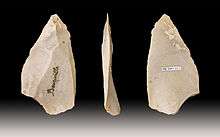
Neanderthals made stone tools, used fire,[61] and were hunters. The consensus on their behaviour ends there. It had long been debated whether Neanderthals were hunters or scavengers,[39] but the discovery of the pre-Neanderthal Schöningen wooden spears in Germany helped settle the debate in favour of hunting. Most available evidence suggests they were apex predators,[62] and fed on red deer, reindeer, ibex, wild boar, aurochs and on occasion mammoth, straight-tusked elephant and rhinoceros.[39][63][64][65] They appear to have occasionally used vegetables as fall-back food,[66] revealed in the 2000s and 2010s by isotope analysis of their teeth and study of their coprolites (fossilised faeces).[64] Dental analysis of specimens from Spy, Belgium and El Sidrón, Spain[67] in 2017 suggested that these Neanderthals had a wide-ranging diet, and that those "from El Sidrón showed no evidence of meat eating" at all and seemed to have lived on "a mixture of forest moss, pine nuts and a mushroom known as split gill".[68]
The size and distribution of Neanderthal sites, along with genetic evidence, suggests Neanderthals lived in much smaller and more sparsely distributed groups than anatomically-modern Homo sapiens.[69][70] The bones of twelve Neanderthals were discovered at El Sidrón cave in northwestern Spain. They are thought to have been a group killed and butchered about 50,000 years ago. Analysis of the mtDNA showed that the three adult males belonged to the same maternal lineage, while the three adult females belonged to different ones. This suggests a social structure where males remained in the same social group and females "married out".[71]
The bones of the El Sidrón group show signs of defleshing, suggesting that they were victims of cannibalism.[71] The St. Césaire 1 skeleton discovered in 1979 at La Roche à Pierrot, France, showed a healed fracture on top of the skull apparently caused by a deep blade wound, suggesting interpersonal violence.[72]
Claims that Neanderthals deliberately buried their dead, and if they did, whether such burials had any symbolic meaning,[40]:158–60 are heavily contested.[73][74][75] The debate on deliberate Neanderthal burials has been active since the 1908 discovery of the well-preserved Chapelle-aux-Saints 1 skeleton in a small hole in a cave in southwestern France. In this controversy's most recent installment, a team of French researchers reinvestigated the Chapelle-aux-Saints cave and in January 2014 reasserted the century-old claim that the 1908 Neanderthal specimen had been deliberately buried,[76] and this has in turn been heavily criticised.[77] A 2018 open access paper discussed, in light of recent developments in the fields of paleogenetics and paleoanthropology, whether or not Neanderthals were rational. The authors' argument focuses on the genetic evidence that supports interbreeding with Homo sapiens, language acquisition (including the FOXP2 gene), archaeological signs of cultural development and potential for cumulative cultural evolution.[78]
Culture
Whether Neanderthals created art and used adornments, which would indicate a capability for complex symbolic thought, remains unresolved. A 2010 paper on radiocarbon dates cast doubt on the association of Châtelperronian beads with Neanderthals,[79] and Paul Mellars considered the evidence for symbolic behavior to have been refuted.[80] This conclusion, however, is controversial, and others such as Jean-Jacques Hublin and colleagues have re-dated material associated with the Châtelperronian artefacts[81] and used proteomic evidence to restate the challenged association with Neanderthals.[82]
A very large number of other claims of Neanderthal art, adornment, and structures have been made. These are often taken by the media as showing Neanderthals were capable of symbolic thought,[83][84] or were "mental equals" to anatomically modern humans.[85][86] As evidence of symbolism, none of them are widely accepted,[87] although the same is true for Middle Palaeolithic anatomically modern humans. Among many others:
- Flower pollen on the body of pre-Neanderthal Shanidar 4, Iraq, had in 1975 been argued to be a flower burial.[88] Once popular, this theory is no longer accepted.[89][90]
- Bird bones were argued to show evidence for feather plucking in a 2012 study examining 1,699 ancient sites across Eurasia, which the authors controversially[91] took to mean Neanderthals wore bird feathers as personal adornments.[92]
- Deep scratches were found in 2012 on a cave floor underlying Neanderthal layer in Gorham's Cave, Gibraltar, which some have controversially[93] interpreted as art.[94]
- Two 176,000-year-old stalagmite ring structures, several metres wide, were reported in 2016 more than 300 metres from the entrance within Bruniquel Cave, France. The authors claim artificial lighting would have been required as this part of the cave is beyond the reach of daylight and that the structures had been made by early Neanderthals, the only humans in Europe at this time.[95]
- In 2015, a study argued that a number of 130,000-year-old eagle talons found in a cache near Krapina, Croatia along with Neanderthal bones, had been modified to be used as jewellery.[96][97]
All of these appeared only in single locations. Yet in 2018, using uranium-thorium dating methods,[98] red painted symbols comprising a scalariform (ladder shape), a negative hand stencil, and red lines and dots on the cave walls of three Spanish caves 700 km (430 mi) apart were dated to at least 64,000 years old.[99] If the dating is correct, they were painted before the time anatomically modern humans are thought to have arrived in Europe. Paleoanthropologist John D. Hawks argues these findings demonstrate Neanderthals were capable of symbolic behavior previously thought to be unique to modern humans.[100]
Interbreeding with archaic and modern humans
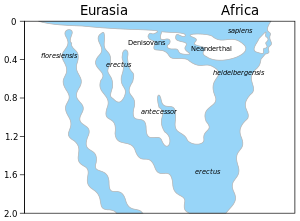
An alternative to extinction is that Neanderthals were absorbed into the Cro-Magnon population by interbreeding. This would be counter to strict versions of the recent African origin theory, since it would imply that at least part of the genome of Europeans would descend from Neanderthals.
Pre-2010 interbreeding hypotheses
Until the early 1950s, most scholars thought Neanderthals were not in the ancestry of living humans.[102]:232–34[103] Nevertheless, Thomas H. Huxley in 1904 saw among Frisians the presence of what he suspected to be Neanderthaloid skeletal and cranial characteristics as an evolutionary development from Neanderthal rather than as a result of interbreeding, saying that "the blond long-heads may exhibit one of the lines of evolution of the men of the Neanderthaloid type," yet he raised the possibility that the Frisians alternatively "may be the result of the admixture of the blond long-heads with Neanderthal men," thus separating "blond" from "Neanderthaloid."[104]
Hans Peder Steensby proposed interbreeding in 1907 in the article Race studies in Denmark. He strongly emphasised that all living humans are of mixed origins.[105] He held that this would best fit observations, and challenged the widespread idea that Neanderthals were ape-like or inferior. Basing his argument primarily on cranial data, he noted that the Danes, like the Frisians and the Dutch, exhibit some Neanderthaloid characteristics, and felt it was reasonable to "assume something was inherited" and that Neanderthals "are among our ancestors."
Carleton Stevens Coon in 1962 found it likely, based upon evidence from cranial data and material culture, that Neanderthal and Upper Paleolithic peoples either interbred or that the newcomers reworked Neanderthal implements "into their own kind of tools."[106] Christopher Thomas Cairney in 1989 went further, laying out a rationale for hybridisation and adding a broader discussion of physical characteristics as well as commentary on interbreeding and its importance to adaptive European phenotypes. Cairney specifically discussed the "intermixture of racial elements" and "hybridisation."[32]
By the early 2000s, the majority of scholars supported the Out of Africa hypothesis,[107][108] according to which anatomically modern humans left Africa about 50,000 years ago and replaced Neanderthals with little or no interbreeding. Yet some scholars still argued for hybridisation with Neanderthals. The most vocal proponent of the hybridisation hypothesis was Erik Trinkaus of Washington University.[109] Trinkaus claimed various fossils as products of hybridised populations, including the skeleton of a child found at Lagar Velho in Portugal[110][111][112] and the Peștera Muierii skeletons from Romania.[113]
Genetic evidence
In 2010, geneticists announced that interbreeding had likely taken place,[114][115] a result confirmed in 2012.[116][117][118] The genomes of all non-Africans include portions that are of Neanderthal origin,[119][120] a share estimated in 2014 to 1.5–2.1%.[121] This DNA is absent in Sub-Saharan Africans (Yoruba people and San subjects).[114] Ötzi the iceman, Europe's oldest preserved mummy, was found to possess an even higher percentage of Neanderthal ancestry.[122] The two percent of Neanderthal DNA in Europeans and Asians is not the same in all Europeans and Asians: in all, approximately 20% of the Neanderthal genome appears to survive in the modern human gene pool.[123]
2012 genetic studies seem to suggest that modern humans may have mated with "at least two groups" of archaic humans: Neanderthals and Denisovans.[124] Some researchers suggest admixture of 3.4–7.9% in modern humans of non-African ancestry, rejecting the hypothesis of ancestral population structure.[125] Detractors have argued and continue to argue that the signal of Neanderthal interbreeding may be due to ancient African substructure, meaning that the similarity is only a remnant of a common ancestor of both Neanderthals and modern humans and not the result of interbreeding.[126][127] John D. Hawks has argued that the genetic similarity to Neanderthals may indeed be the result of both structure and interbreeding, as opposed to just one or the other.[128]
An approximately 40,000 year old anatomically-modern human skeleton from Peștera cu Oase, Romania, was found in 2015 to have a much larger proportion of DNA matching the Neanderthal genome than seen in humans of today, and this was estimated to have resulted from an inbreeding event as few as four generations earlier. However, this hybrid Romania population does not appear to have made a substantial contribution to the genomes of later Europeans.[129][130]
While some modern human nuclear DNA has been linked to the extinct Neanderthals, no mitochondrial DNA of Neanderthal origin has been detected,[15] which in primates is always maternally transmitted. This observation has prompted the hypothesis that whereas female humans interbreeding with male Neanderthals were able to generate fertile offspring, the progeny of female Neanderthals who mated with male humans were either rare, absent or sterile.[131]
Interbreeding with Denisovans
Sequencing of the genome of a Denisovan, a distinct but related archaic hominin, from the Denisova cave in the Siberian Altai region has shown that 17% its genome represents Neanderthal DNA.[132] Unsurprisingly, the genome from a 120,000 year old Neanderthal bone found in the same cave more closely resembled the Neanderthal DNA present in the Denisovan genome than that of Neanderthals from the Vindija cave in Croatia or the Mezmaiskaya cave in the Caucasus, suggesting that the gene flow came from a local interbreeding.[133] However, the complete genome sequencing of DNA from a 90,000 year old bone fragment, Denisova 11, showed it to have belonged to a Denisovan-Neanderthal hybrid, whose father was a typical Denisovan with the Altai Neanderthal component dating to an interbreeding more than 300 generations earlier, but the specimen's mother was a Neanderthal belonging to a population more closely related to the Vindija Neanderthal than to the sequenced Altai Neanderthal genome. This suggests mobility or turnover among the distinct Neanderthal populations.[134][135][136][137]
Extinction
According to a 2014 study by Thomas Higham and colleagues of organic samples from European sites, Neanderthals died out in Europe between 41,000 and 39,000 years ago.[lower-alpha 4] New dating in Iberia, where Neanderthal dates as late as 28,000 years had been reported, suggests evidence of Neanderthal survival in the peninsula after 42,000 years ago is almost non-existent.[8]
Anatomically modern humans arrived in Mediterranean Europe between 45,000 and 43,000 years ago, so the two different human populations shared Europe for several thousand years.[6][138] The exact nature of biological and cultural interaction between Neanderthals and other human groups is contested.[139]
Possible scenarios for the extinction of the Neanderthals are:
- Neanderthals were a separate species from modern humans, and became extinct (because of climate change or interaction with modern humans) and were replaced by modern humans moving into their habitat between 45,000 and 40,000 years ago.[140] Jared Diamond has suggested a scenario of violent conflict and displacement.[141]
- Neanderthals were a contemporary subspecies that bred with modern humans and disappeared through absorption (interbreeding theory).
- Volcanic catastrophe: see Campanian Ignimbrite Eruption
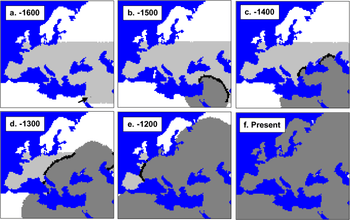
Climate change
About 55,000 years ago, the climate began to fluctuate wildly from extreme cold conditions to mild cold and back in a matter of decades. Neanderthal bodies were well-suited for survival in a cold climate—their stocky chests and limbs stored body heat better than the Cro-Magnons. Neanderthals died out in Europe between 41,000 and 39,000 years ago, apparently coinciding with the start of a very cold period.[143][144] Raw material sourcing and the examination of faunal remains by Adler et al. (2006) in the southern Caucasus suggest that modern humans may have had a survival advantage during this period, being able to use social networks to acquire resources from a greater area. They found that in both the Late Middle Palaeolithic and Early Upper Palaeolithic more than 95% of stone artifacts were drawn from local material, suggesting Neanderthals restricted themselves to more local sources.[145]
Coexistence with modern humans
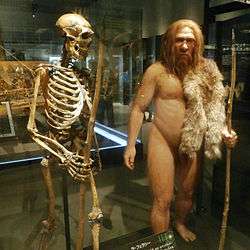
In November 2011 tests conducted at the Oxford Radiocarbon Accelerator Unit in England on what were previously thought to be Neanderthal baby teeth, which had been unearthed in 1964 from the Grotta del Cavallo in Italy, were identified as the oldest modern human remains discovered anywhere in Europe, dating from between 43,000 and 45,000 years ago.[146] Given that the 2014 study by Thomas Higham of Neanderthal bones and tools indicates that Neanderthals died out in Europe between 41,000 and 39,000 years ago, the two different human populations shared Europe for as long as 5,000 years.[143] Nonetheless, the exact nature of biological and cultural interaction between Neanderthals and other human groups has been contested.[139]
Modern humans co-existed with them in Europe starting around 45,000 years ago and perhaps even earlier. Neanderthals inhabited that continent long before the arrival of modern humans. These modern humans may have introduced a disease that contributed to the extinction of Neanderthals, and that may be added to other recent explanations for their extinction. When Neanderthal ancestors left Africa potentially as early as over 800,000 years ago they adapted to the pathogens in their European environment, unlike modern humans who adapted to African pathogens. This transcontinental movement is known as the Out of Africa model. If contact between humans and Neanderthals occurred in Europe and Asia the first contact may have been devastating to the Neanderthal population, because they would have had little if any immunity to the African pathogens. More recent historical events in Eurasia and the Americas show a similar pattern, where the unintentional introduction of viral or bacterial pathogens to unprepared populations has led to mass mortality and local population extinction.[147] The most well-known example of this is the arrival of Christopher Columbus to the New World, which brought and introduced foreign diseases when he and his crew arrived to a native population who had no immunity.
Anthropologist Pat Shipman, of Pennsylvania State University, suggested that domestication of the dog could have played a role in Neanderthals' extinction.[148]
History of research
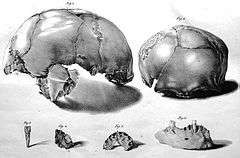
a.jpg)
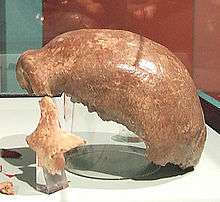
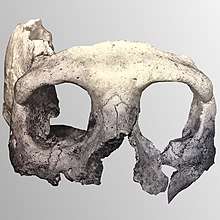
Neanderthal fossils were first discovered in 1829 in the Engis caves (the partial skull dubbed Engis 2), in what is now Belgium by Philippe-Charles Schmerling and the Gibraltar 1 skull in 1848 in the Forbes' Quarry, Gibraltar. These finds were not, at the time, recognized as representing an archaic form of humans.
The first discovery which was recognized as representing an archaic form of humans was made in August 1856, three years before Charles Darwin's On the Origin of Species was published. This was the discovery of the type specimen, Neanderthal 1, in a limestone quarry (Feldhofer Cave), located in Neandertal Valley in the German Rhineland, about 12 km (7 mi) east of Düsseldorf). The find consisted of a skull cap, two femora, three bones of the right arm, two of the left arm, parts of the left ilium, fragments of a scapula, and ribs. The workers who recovered the objects originally thought them to be the remains of a cave bear. However, they eventually gave the material to amateur naturalist Johann Carl Fuhlrott, who turned the fossils over to anatomist Hermann Schaaffhausen.[150]
To date, the bones of over 400 Neanderthals have been found.[151]
- 1829: A damaged skull of a Neanderthal child, Engis 2, is discovered in Engis, Netherlands (now Belgium).
- 1848: A female Neanderthal skull, Gibraltar 1, is found in Forbes' Quarry, Gibraltar, but its importance is not recognised.
- 1856: Limestone miners discover the Neanderthal-type specimen, Neanderthal 1, in Neandertal, western Prussia (now Germany).
- 1864: William King is the first to recognise Neanderthal 1 as belonging to a separate species, for which he gives the scientific name Homo neanderthalensis. He then changed his mind on placing it in the genus Homo, arguing that the upper skull was different enough to warrant a separate genus since, to him, it had likely been "incapable of moral and theistic conceptions."[17]
- 1880: The mandible of a Neanderthal child is discovered in a secure context in Šipka cave, in the Austro-Hungarian Empire (now the Czech Republic), associated with cultural debris, including hearths, Mousterian tools, and bones of extinct animals.
- 1886: Two well-preserved Neanderthal skeletons are found at Spy, Belgium, making the hypothesis that Neanderthal 1 was only a diseased modern human difficult to sustain.[152]
- 1899: Sand excavation workers find hundreds of fragmentary Neanderthal remains representing at least 12 and likely as much as 70 individuals on a hill in Krapina, in the Austro-Hungarian Empire (now Croatia).
- 1908: A very well preserved Neanderthal, La Chapelle-aux-Saints 1, is found in its eponymous site in France,[153] said by the excavators to be a burial, a claim still heatedly contested.[77][73][74] For historical reasons it remains the most famous Neanderthal skeleton.[40]:15
- 1912: Marcellin Boule publishes his now discredited influential study of Neanderthal skeletal morphology based on La Chapelle-aux-Saints 1.
- 1953–1957: Ten Neanderthal skeletons are excavated in Shanidar Cave, Iraqi Kurdistan, by Ralph Solecki and colleagues.
- 1975: Erik Trinkaus's study of Neanderthal feet strongly argues that Neanderthals walked like modern humans.
- 1981: The site of Bontnewydd, Wales yielded an early Neanderthal tooth, the most north-western Neanderthal remain ever.
- 1987: Israeli Neanderthal Kebara 2 is dated (by TL and ESR) to 60,000 BP, thus later than the Israeli anatomically modern humans dated to 90,000 and 80,000 BP at Qafzeh and Skhul.
- 1997: Matthias Krings et al. are the first to amplify Neanderthal mitochondrial DNA (mtDNA) using a specimen from Feldhofer grotto in the Neander valley.[15]
- 2005: The Max Planck Institute for Evolutionary Anthropology and associated institutions launch the Neanderthal genome project to sequence the Neanderthal nuclear genome.[154]
- 2010: Discovery of Neanderthal admixture in the genome of modern populations.[114][116][117]
- 2014: A comprehensive dating of Neanderthal bones and tools from hundreds of sites in Europe dates the disappearance of Neanderthals to 41,000 and 39,000 years ago.[155]
- 2018: Report on the complete genomic sequence of Denisova 11, a first generation of Neanderthal-Denisovan hybrid.
Specimens
Notable European Neanderthals
Remains of more than 300 European Neanderthals have been found. For the most important, see List of human evolution fossils.
- Neanderthal 1: The first human bones recognised as showing a non-modern anatomy. Discovered in 1856 in a limestone quarry at the Feldhofer grotto in Neanderthal, Germany, they consist of a skull cap, the two femora, the three right arm bones, two left arm bones, the ilium, and fragments of a scapula and ribs.
- La Chapelle-aux-Saints 1: Called the Old Man, a fossilised skull discovered in La Chapelle-aux-Saints, France, by A. and J. Bouyssonie, and L. Bardon in 1908. Characteristics include a low vaulted cranium and large browridge typical of Neanderthals. Estimated to be about 60,000 years old, the specimen was severely arthritic and had lost all his teeth long before death, leading some to suggest he was cared for by others.
- La Ferrassie 1: A fossilised skull discovered in La Ferrassie, France, by R. Capitan in 1909. It is estimated to be 70,000 years old. Its characteristics include a large occipital bun, low-vaulted cranium and heavily worn teeth.
- Le Moustier 1: One of the rare nearly complete Neanderthal skeletons to be discovered, it was excavated by a German team in 1908, at Peyzac-le-Moustier, France. Sold to a Berlin museum, the post cranial skeleton was bombed and mostly destroyed in 1945, and parts of the mid face were lost sometime after then. The skull, estimated to be less than 45,000 years old, includes a large nasal cavity and a less developed brow ridge and occipital bun than seen in other Neanderthals. The Mousterian tool techno-complex is named after its discovery site.
Notable Southwest Asian Neanderthals
Remains of more than 70 Southwest Asian Neanderthals have been found. For a complete list see List of Southwest Asian Neanderthals.
- Shanidar 1 to 10: Eight Neanderthals and two pre-Neanderthals (Shanidar 2 and 4) were discovered in the Zagros Mountains in Iraqi Kurdistan. One of the skeletons, Shanidar 4, was once thought to have been buried with flowers, a theory no longer accepted. To Paul B. Pettitt the "deliberate placement of flowers has now been convincingly eliminated", since "[a] recent examination of the microfauna from the strata into which the grave was cut suggests that the pollen was deposited by the burrowing rodent Meriones tersicus, which is common in the Shanidar microfauna and whose burrowing activity can be observed today".[156]
- Amud 1: A male adult Neanderthal, dated to roughly 55,000 BP, and one of several found in a cave at Nahal Amud, Israel. At 178 cm (70 in), it is the tallest known Neanderthal. It also has the largest cranial capacity of all extinct hominins: 1,736 cm3.[39][157]
- Kebara 2: A male adult post-cranial skeleton, dated to roughly 60,000 BP, that was discovered in 1983 in Kebara Cave, Israel. It has been studied extensively, for its hyoid, ribcage, and pelvis are much better preserved than in all other Neanderthal specimens.
Notable Central Asian Neanderthal
- Teshik-Tash 1: An 8–11-year-old skeleton discovered in Uzbekistan by Okladnikov in 1938. This is the only fairly complete skeleton discovered to the east of Iraq. Okladnikov claimed it was a deliberate burial, but this is debated.
Chronology
This section describes bones with Neanderthal traits in chronological order.
Mixed with H. heidelbergensis traits
- > 350 ka: Sima de los Huesos c. 500:350 ka ago[158]
- 350–200 ka: Pontnewydd 225 ka ago.
- 200–135 ka: Atapuerca,[159] Vértesszőlős, Ehringsdorf, Casal de'Pazzi, Biache, La Chaise, Montmaurin, Prince, Lazaret, Fontéchevade
H. neanderthalensis fossils
- 130–50 ka: Krapina, Saccopastore skulls, Malarnaud, Altamura, Gánovce, Denisova, Okladnikov, Pech de l'Azé, Tabun 120–100±5 ka,[160] Shanidar 1 to 9 80–60 ka, La Ferrassie 1 70 ka, Kebara 60 ka, Régourdou, Mt. Circeo, Combe Grenal, Erd 50 ka, La Chapelle-aux Saints 1 60 ka, Amud I 53±8 ka,[161][162] Teshik-Tash.
- In radiocarbon range, > 50 ka: Le Moustier, Feldhofer, La Quina, l'Hortus, Kulna, Šipka, Saint Césaire, Bacho Kiro, El Castillo, Bañolas, El Sidrón (48±3 cal ka),[163] Arcy-sur-Cure, Châtelperron, Figueira Brava, Mezmaiskaya (41±1 cal ka),[7] Zafarraya, Vindija, Velika Pećina.
H. s. sapiens with traits reminiscent of Neanderthals
- < 35 Peștera cu Oase 37-42 ka, Mladeč 31 ka, Pestera Muierii 30 ka (n/s),[164] Lagar Velho 1 24.5 ka.
In popular culture
Neanderthals have been portrayed in popular culture including appearances in literature, visual media and comedy. Early 20th century artistic interpretations often presented Neanderthals as beastly creatures, emphasising hairiness and rough, dark complexion.[165]
See also
Notes
- ↑ The German noun is cognate with English dale. The German /t/ phoneme was frequently spelled th throughout the 15th to 19th centuries; Tal became standardized with the German spelling reform of 1901, thus the German name Neandertal for both the valley and species/subspecies.
- ↑ There are modern humans with noses as wide as those of Neanderthals and modern humans with similar nose lengths, but none with both Neanderthal nose width and nose length.
- ↑ Homo floresiensis originated in an unknown location from unknown ancestors and reached remote parts of Indonesia. Homo erectus spread from Africa to western Asia, then east Asia and Indonesia; its presence in Europe is uncertain, but it gave rise to Homo antecessor, found in Spain. Homo heidelbergensis originated from Homo erectus in an unknown location and dispersed across Africa, southern Asia and southern Europe (other scientists interpret fossils, here named heidelbergensis, as late erectus). Homo sapiens sapiens spread from Africa to western Asia and then to Europe and southern Asia, eventually reaching Australia and the Americas. In addition to Neanderthals and Denisovans, a third gene flow of archaic Africa origin is indicated at the right.[101]
- ↑ Higham et al did not study samples from sites outside Europe and they stated that further work was required to rule out later survival at Gorhams Cave, Gibraltar.[6]
References
- 1 2 3 Howell, F. Clark (1957). "The evolutionary significance of variation and varieties of 'Neanderthal' man". The Quarterly Review of Biology. 32 (4): 330–47. doi:10.1086/401978. JSTOR 2816956. PMID 13506025. Foley, Tim. TalkOrigins Archive. "Neanderthal or Neandertal?". 2005.
- ↑ Romeo, Luigi (1979). Ecce Homo!:A Lexicon of Man. Amsterdam: John Benjamins Publishing Company. p. 92. ISBN 9027220069.
- ↑ Camp, C. L; Allison, H. J.; Nichols, R. H. (1964). Bibliography of Fossil Vertebrates 1954–1958. New York: The Geological Society of America, Inc. p. 556. ISBN 9780813710921.
- ↑ "Neanderthal in ODE". Oxford Dictionaries. "'Neanderthal' in Random House Dictionary (US) & Collins Dictionary (UK)". Dictionary.com.
- 1 2 Pääbo, Svante (2014). Neanderthal Man: In Search of Lost Genomes. New York: Basic Books. p. 237.
- 1 2 3 T. Higham, K. Douka, R. Wood, C.B. Ramsey, F. Brock, L. Basell, M. Camps, A. Arrizabalaga, J. Baena, C. Barroso-Ruíz, C. Bergman, C. Boitard, P. Boscato, M. Caparrós, N.J. Conard, C. Draily, A. Froment, B. Galván, P. Gambassini, A. Garcia-Moreno, S. Grimaldi, P. Haesaerts, B. Holt, M.-J. Iriarte-Chiapusso, A. Jelinek, J.F. Jordá Pardo, J.-M. Maíllo-Fernández, A. Marom, J. Maroto, M. Menéndez, L. Metz, E. Morin, A. Moroni, F. Negrino, E. Panagopoulou, M. Peresani, S. Pirson, M. de la Rasilla, J. Riel-Salvatore, A. Ronchitelli, D. Santamaria, P. Semal, L. Slimak, J. Soler, N. Soler, A. Villaluenga, R. Pinhasi, R. Jacobi (2014). "The timing and spatiotemporal patterning of Neanderthal disappearance". Nature. 512 (7514): 306–09. Bibcode:2014Natur.512..306H. doi:10.1038/nature13621. PMID 25143113.
We show that the Mousterian [the Neanderthal tool-making tradition] ended by 41,030–39,260 calibrated years BP (at 95.4% probability) across Europe. We also demonstrate that succeeding 'transitional' archaeological industries, one of which has been linked with Neanderthals (Châtelperronian), end at a similar time.
T. Higham (2011). "European Middle and Upper Palaeolithic radiocarbon dates are often older than they look: problems with previous dates and some remedies" (PDF). Antiquity. 85 (327): 235–49. doi:10.1017/s0003598x00067570.Few events of European prehistory are more important than the transition from ancient to modern humans around 40 000 years ago, a period that unfortunately lies near the limit of radiocarbon dating. This paper shows that as many as 70 per cent of the oldest radiocarbon dates in the literature may be too young, due to contamination by modern carbon.
- 1 2 R. Pinhasi, T.F.G. Higham, L.V. Golovanova, V.B. Doronichev (2011). "Revised age of late Neanderthal occupation and the end of the Middle Paleolithic in the northern Caucasus". Proceedings of the National Academy of Sciences USA. 108 (21): 8611–16. Bibcode:2011PNAS..108.8611P. doi:10.1073/pnas.1018938108. PMC 3102382.
The direct date of the fossil (39,700 ± 1,100 14C BP) is in good agreement with the probability distribution function, indicating at a high level of probability that Neanderthals did not survive at Mezmaiskaya Cave after 39 ka cal BP. [...] This challenges previous claims for late Neanderthal survival in the northern Caucasus. [...] Our results confirm the lack of reliably dated Neanderthal fossils younger than ≈40 ka cal BP in any other region of Western Eurasia, including the Caucasus.
- 1 2 B. Galván, C.M. Hernández, C. Mallol, N. Mercier, A. Sistiaga, V. Soler (2014). "New evidence of early Neanderthal disappearance in the Iberian Peninsula" (PDF). Journal of Human Evolution. 75: 16–27. doi:10.1016/j.jhevol.2014.06.002. PMID 25016565.
- ↑ McKie, Robin (June 2, 2013). "Why did the Neanderthals die out?". The Guardian. Retrieved April 6, 2017.
"It was once thought we appeared in Europe around 35,000 years ago and that we coexisted with Neanderthals for thousands of years after that. They may have hung on in pockets – including caves in Gibraltar – until 28,000 years ago [said Chris Stringer]" Previous research on Neanderthal sites which suggested that they were more recent than 40,000 years old appears to be wrong," said Stringer. "That is a key finding that will be discussed at the conference."[...] However, scientists have set out to get round these problems. At Oxford University, scientists led by Tom Higham have developed new methods to remove contamination and have been able to make much more precise radiocarbon dating for this period.
- ↑ Shaw, Ian; Jameson, Robert, eds. (1999). A Dictionary of Archaeology. Blackwell. p. 408. ISBN 0-631-17423-0. Retrieved August 1, 2016.
- ↑ Stringer, C. (1984). "Human evolution and biological adaptation in the Pleistocene". In Foley, R. Hominid evolution and community ecology. New York: Academic Press. ISBN 978-0122619205. Holloway, R.L. (1985). "The poor brain of Homo sapiens neanderthalensis: see what you please". In Delson, E. Ancestors: The hard evidence. New York: Alan R. Liss. ISBN 978-0471843764. ; extending to 1,736 cm3 (105.9 cu in) in the male Amud 1. Amano, H.; Kikuchi, T.; Morita, Y.; Kondo, O.; Suzuki, Hiromasa; et al. (August 2015). "Virtual Reconstruction of the Neanderthal Amud 1 Cranium". American Journal of Physical Anthropology. 158 (2): 185–97. doi:10.1002/ajpa.22777.
- ↑ Beals, Kenneth; Smith, Courtland; Dodd, Stephen (1984). "Brain Size, Cranial Morphology, Climate, and Time Machines" (PDF). Current Anthropology. 12 (3): 301–30. doi:10.1086/203138.
- 1 2 Helmuth H (1998). "Body height, body mass and surface area of the Neanderthals". Zeitschrift für Morphologie und Anthropologie. 82 (1): 1–12. PMID 9850627.
- ↑ Sánchez-Quinto, F; Botigué, LR; Civit, S; Arenas, C; Avila-Arcos, MC; Bustamante, CD; Comas, D; Lalueza-Fox, C (October 17, 2012). "North African Populations Carry the Signature of Admixture with Neandertals". PLOS One. 7 (10): e47765. Bibcode:2012PLoSO...747765S. doi:10.1371/journal.pone.0047765. PMC 3474783. PMID 23082212. Retrieved May 29, 2016. Fu, Q; Li, H; Moorjani, P; Jay, F; Slepchenko, SM; Bondarev, AA; Johnson, PL; Aximu-Petri, A; Prüfer, K; de Filippo, C; Meyer, M; Zwyns, N; Salazar-García, DC; Kuzmin, YV; Keates, SG; Kosintsev, PA; Razhev, DI; Richards, MP; Peristov, NV; Lachmann, M; Douka, K; Higham, TF; Slatkin, M; Hublin, JJ; Reich, D; Kelso, J; Viola, TB; Pääbo, S (October 23, 2014). "Genome sequence of a 45,000-year-old modern human from western Siberia". Nature. 514 (7523): 445–49. Bibcode:2014Natur.514..445F. doi:10.1038/nature13810. PMC 4753769. PMID 25341783. Brahic, Catherine. "Humanity's forgotten return to Africa revealed in DNA", The New Scientist (February 3, 2014).
- 1 2 3 Krings, Matthias; Stone, Anne; Schmitz, Ralf W; Krainitzki, Heike; Stoneking, Mark; Pääbo, Svante (1997). "Neandertal DNA Sequences and the Origin of Modern Humans". Cell. 90 (1): 19–30. doi:10.1016/S0092-8674(00)80310-4. ISSN 0092-8674. PMID 9230299. M. Krings (1999). "DNA sequence of the mitochondrial hypervariable region II from the Neandertal type specimen". Proceedings of the National Academy of Sciences USA. 96 (10): 5581–85. Bibcode:1999PNAS...96.5581K. doi:10.1073/pnas.96.10.5581. PMC 21903. P. Beerli; S.V. Edwards (2002). "When did Neanderthals and modern humans diverge?" (PDF). Evolutionary Anthropology. 11 (S1): 60–63. doi:10.1002/evan.10058.
- ↑ Vogt, Karl C (1864). Lectures on Man: His Place in Creation, and in the History of the Earth. London: Longman, Green, Longman and Roberts. pp. 302, 473.
- 1 2 King, William (Jan 1864). "The Reputed Fossil Man of the Neanderthal" (PDF). The Quarterly Journal of Science. 1: 96.
- ↑ Inter alia, Boys' Life, p. 18. January 1924.
- ↑ The Oxford Illustrated Dictionary. Great Britain: Oxford University Press. 1976 [1975]. p. 564.
(tahl)
- ↑ "Neanderthal adjective – definition in British English Dictionary & Thesaurus". Dictionary.cambridge.org. January 8, 2013. Retrieved January 22, 2013.
- ↑ "Oxford Learner's Dictionaries – Find pronunciation, clear meanings and definitions of words". OxfordLearnersDictionaries.com.
- ↑ Kurtén, Björn (October 10, 1995). Dance of the Tiger: A Novel of the Ice Age. University of California Press. p. xxi. ISBN 0-520-20277-5. Retrieved May 9, 2012. Pollet, Carl J. (September 21, 1991). "...And Etymology". Science News. 140 (12): 191. doi:10.2307/3975867. JSTOR 3975867.
- ↑ "Neanderthal | Define Neanderthal at Dictionary.com". Dictionary.reference.com. Retrieved January 22, 2013.
- ↑ "Neanderthal". Wiley-Blackwell Encyclopedia of Human Evolution. Chichester, West Sussex: Wiley-Blackwell. 2013.
- ↑ "Neandertal oder Neanderthal? – Was ist denn nun richtig?". mettmann.de. Neanderthal museum. Retrieved February 1, 2017.
Heute sollten Ortsbezeichnungen das 'Neandertal' ohne 'h' bezeichnen. Alle Namen, die sich auf den prähistorischen Menschen beziehen, führen das 'h'. [Today one should write for place names 'Neandertal' without an 'h'. All names related to the prehistoric humans keep the 'h'.]
- ↑ Tattersall, Ian; Schwartz, Jeffrey H. (1999). "Hominids and hybrids: The place of Neanderthals in human evolution". Proceedings of the National Academy of Sciences. 96 (13): 7117–19. Bibcode:1999PNAS...96.7117T. doi:10.1073/pnas.96.13.7117. JSTOR 48019. PMC 33580. PMID 10377375.
- ↑ Duarte, C.; Mauricio, J.; Pettitt, P. B. (1999). "The early Upper Paleolithic human skeleton from the Abrigo do Lagar Velho (Portugal) and modern human emergence in Iberia". Proceedings of the National Academy of Sciences. 96 (13): 7604–09. Bibcode:1999PNAS...96.7604D. doi:10.1073/pnas.96.13.7604. ISSN 0027-8424. PMC 22133. PMID 10377462. Retrieved June 21, 2009.
- ↑ Hublin, J. J. (2009). "The origin of Neandertals". Proceedings of the National Academy of Sciences. 106 (38): 16022–27. Bibcode:2009PNAS..10616022H. doi:10.1073/pnas.0904119106. JSTOR 40485013. PMC 2752594. PMID 19805257. Harvati, K.; Frost, S.R.; McNulty, K.P. (2004). "Neanderthal taxonomy reconsidered: implications of 3D primate models of intra- and interspecific differences". Proc. Natl. Acad. Sci. USA. 101 (5): 1147–52. Bibcode:2004PNAS..101.1147H. doi:10.1073/pnas.0308085100. PMC 337021. PMID 14745010.
- ↑ "L'homme fossile de La Chapelle-aux-Saints – full text: Volume VI (pp. 11–172), Volume VII (pp. 21–56), Volume VIII (pp. 1–70), 1911–13". Royal College of Surgeons of England. Retrieved July 26, 2016.
- ↑ "Our Neandertal Brethren: Why They Were Not a Separate Species". Scientific American. August 1, 2010. Retrieved July 26, 2016.
- ↑ Wolpoff, MH; Hawks, J; Caspari, R (2000). "Multiregional, not multiple origins" (PDF). American Journal of Physical Anthropology. 112 (1): 129–36. doi:10.1002/(SICI)1096-8644(200005)112:1<129::AID-AJPA11>3.0.CO;2-K. PMID 10766948.
- 1 2 Cairney, Christopher Thomas (1989). Clans and Families of Ireland and Scotland, an Ethnography of the Gael. London: McFarland. p. 14. ISBN 978-0899503622.
- ↑ 410–440 ka P. Endicott; S.Y.W. Ho; C. Stringer (2010). "Using genetic evidence to evaluate four palaeoanthropological hypotheses for the timing of Neanderthal and modern human origins" (PDF). Journal of Human Evolution. 59 (1): 87–95. doi:10.1016/j.jhevol.2010.04.005. PMID 20510437.
- ↑ 295–498 ka. A. Rieux (2014). "Improved calibration of the human mitochondrial clock using ancient genomes". Molecular Biology and Evolution. 31 (10): 2780–92. doi:10.1093/molbev/msu222. PMC 4166928. PMID 25100861.
- ↑ Fenton, Bruce R. (August 8, 2017). "Neanderthal Genome Study Reveals Homo sapiens Lineage Diverged 744,000 Years Ago, Huge Gap in Fossil Record Indicated". Ancientnews.net. Retrieved October 2, 2018.
- ↑ Alan R. Rogers, Ryan J. Bohlender, Chad D. Huff, "Early history of Neanderthals and Denisovans", PNAS 114 (37), September 12, 2017, 9859–63, doi:10.1073/pnas.1706426114; see also: Jordana Cepelewicz, "Genetics Spills Secrets From Neanderthals' Lost History," Quanta Magazine, September 18, 2017. "The dating of that schism between the Neanderthals and the Denisovans is surprising because previous research had pegged it as much more recent: a 2016 study, for instance, set it at only 450,000 years ago. An earlier separation means we should expect to find many more fossils of both eventually. It also changes the interpretation of some fossils that have been found. Take the large-brained hominid bones belonging to a species called Homo heidelbergensis, which lived in Europe and Asia around 600,000 years ago. Paleoanthropologists have disagreed about how they relate to other human groups, some positing they were ancestors of both modern humans and Neanderthals, others that they were a nonancestral species replaced by the Neanderthals, who spread across Europe."
- ↑ Matthias Meyer, Juan-Luis Arsuaga, Cesare de Filippo, Sarah Nagel, Ayinuer Aximu-Petri, Birgit Nickel, Ignacio Martínez, Ana Gracia, José María Bermúdez de Castro, Eudald Carbonell, Bence Viola, Janet Kelso, Kay Prüfer & Svante Pääbo, "Nuclear DNA sequences from the Middle Pleistocene Sima de los Huesos hominins", Nature 531, pp. 504–07 (March 24, 2016), doi:10.1038/nature17405. Ewen Callaway, "Oldest ancient-human DNA details dawn of Neanderthals" Sequence of 430,000-year-old DNA pushes back divergence of humans and Neanderthals", Nature News, March 14, 2016.
- 1 2 D. Dean; J.-J. Hublin; R. Holloway; R. Ziegler (1998). "On the phylogenetic position of the pre-Neandertal specimen from Reilingen, Germany". Journal of Human Evolution. 34 (5). pp. 485–508. doi:10.1006/jhev.1998.0214.
- 1 2 3 4 5 Papagianni, Dmitra; Morse, Michael (2013). The Neanderthals Rediscovered. Thames & Hudson. ISBN 978-0-500-05177-1.
- 1 2 3 Stringer, C.; Gamble, C. (1993). In Search of the Neanderthals. London: Thames and Hudson. ISBN 978-0500050705.
- ↑ B. Vandermeersch; M.D. Garralda (2011). S. Condemi; G.-C. Weniger, eds. "Continuity or Discontinuity in the Peopling of Europe: One Hundred and Fifty Years of Neanderthal Study". Vertebrate Paleobiology and Paleoanthropology. Springer Netherlands. pp. 113–25. doi:10.1007/978-94-007-0492-3_10.
- ↑ N.J. Conard; J. Richter, eds. (2011). "2". Neanderthal Lifeways, Subsistence and Technology. Vertebrate Paleobiology and Paleoanthropology. 19. Springer. pp. 7–14. doi:10.1007/978-94-007-0415-2_2. ISBN 978-9400704145.
- ↑ "Ancient tooth provides evidence of Neanderthal movement" (Press release). Durham University. February 11, 2008. Retrieved May 18, 2009.
- ↑ Wade, Nicholas (October 2, 2007). "Fossil DNA Expands Neanderthal Range". The New York Times. Retrieved May 18, 2009. Ravilious, Kate (October 1, 2007). "Neandertals Ranged Much Farther East Than Thought". National Geographic Society. Retrieved May 18, 2009.
- ↑ Pavlov P, Roebroeks W, Svendsen JI (2004). "The Pleistocene colonization of northeastern Europe: a report on recent research". Journal of Human Evolution. 47 (1–2): 3–17. doi:10.1016/j.jhevol.2004.05.002. PMID 15288521. Slimak, L., et al. (2012). "Response to 'Comment on Late Mousterian Persistence near the Arctic Circle'" Science, 335 (6065), 167 doi:10.1126/science.1210211 Zwyns, N., et al. (2012). "Comment on 'Late Mousterian Persistence near the Arctic Circle'" Science, 335 (6065), 167 doi:10.1126/science.1209908
- ↑ Fabrizio Mafessoni, Kay Prüfer, "Better support for a small effective population size of Neandertals and a long shared history of Neandertals and Denisovans", PNAS 114 (48), November 28, 2017, E10256–E10257, doi:10.1073/pnas.1716918114. Alan R. Rogers, Ryan J. Bohlender, Chad D. Huff, "Early history of Neanderthals and Denisovans", PNAS 114 (37), September 12, 2017, 9859–63, doi:10.1073/pnas.1706426114.
- ↑ Puech, Pierre-François; Puech, Bernard. "L'Homme de Neanderthal par Paul Dardé : L'Homme Primitif" [Neanderthal Man by Paul Dardé: Primitive Man]. Academia.edu (in French). Retrieved July 5, 2017.
- 1 2 Froehle, Andrew W; Churchill, Steven E (2009). "Energetic Competition Between Neandertals and Anatomically Modern Humans" (PDF). PaleoAnthropology: 96–116. Retrieved October 31, 2011.
- ↑ Lalueza-Fox, C.; Rompler, H.; Caramelli, D.; Staubert, C.; Catalano, G.; Hughes, D.; Rohland, N.; Pilli, E.; Longo, L.; Condemi, S.; de la Rasilla, M.; Fortea, J.; Rosas, A.; Stoneking, M.; Schoneberg, T.; Bertranpetit, J.; Hofreiter, M. (2007). "A Melanocortin 1 Receptor Allele Suggests Varying Pigmentation Among Neanderthals" (PDF). Science. 318 (5855): 1453–55. Bibcode:2007Sci...318.1453L. doi:10.1126/science.1147417. ISSN 0036-8075. PMID 17962522. Retrieved September 10, 2017.
- ↑ The 10,000 Year Explosion: How Civilizations Accelerated Human Evolution (2009). Gregory Cochran and Henry Harpending. Basic Books, New York
- ↑ de Azevedo, S.; González, M. F.; Cintas, C.; Ramallo, V.; Quinto-Sánchez, M.; Márquez, F.; Hünemeier, T.; Paschetta, C.; Ruderman, A.; Navarro, P.; Pazos, B.; Silva de Cerqueira, C.; Velan, O.; Ramírez-Rozzi, F.; Calvo, N.; Castro, H.; Paz, R.R.; González-José, R. (October 30, 2017). "Nasal airflow simulations suggest convergent adaptation in Neanderthals and modern humans". Proceedings of the National Academy of Sciences. 114: 201703790. doi:10.1073/pnas.1703790114. ISSN 0027-8424. PMC 5703271. PMID 29087302.
- ↑ Gray, Richard (February 15, 2017). "Your face is probably more primitive than a Neanderthal's". BBC News.
- ↑ Hoffecker, JF (2009). "The spread of modern humans in Europe". Proc. Natl. Acad. Sci. USA. 106: 16040. Bibcode:2009PNAS..10616040H. doi:10.1073/pnas.0903446106. PMC 2752585. – References 399 Hoffecker JF, Cleghorn ...
- ↑ "Neanderthal brains focused on vision and movement leaving less room for social networking". Science Daily. March 19, 2013.
- ↑ SINC Servicio de Información y Noticias Científicas. "El cerebro neandertal era más asimétrico que el del 'Homo sapiens'".
- ↑ Braun, David Maxwell (September 9, 2008). "Neanderthal Brain Size at Birth Sheds Light on Human Evolution". National Geographic. Retrieved September 19, 2009.
- ↑ Silberman, Neil. The Oxford Companion to Archaeology, p. 455 (Oxford University Press 2012): "[I]t is with the Neanderthals that we see the full achievement, for the first time, of the degree of encephalization (brain to body size ratio) that characterizes modern humans."
- ↑ Abramiuk, Marc. The Foundations of Cognitive Archaeology, p. 199 (MIT Press 2012): "the encephalization quotient was slightly smaller".
- ↑ Karakostis, Fotios Alexandros; Hotz, Gerhard; Tourloukis, Vangelis; Harvati, Katerina (26 September 2018). "Evidence for precision grasping in Neandertal daily activities". 4 (9). Science Advances. doi:10.1126/sciadv.aat2369.
- ↑ Zanolli, Clément; Martinón-Torres, María; Bernardini, Federico; Boschian, Giovanni; Coppa, Alfredo; Dreossi, Diego; Mancini, Lucia; Martínez de Pinillos, Marina; Martín-Francés, Laura; Bermúdez de Castro, José María; Tozzi, Carlo; Tuniz, Claudio; Macchiarelli, Roberto (3 October 2018). "The Middle Pleistocene (MIS 12) human dental remains from Fontana Ranuccio (Latium) and Visogliano (Friuli-Venezia Giulia), Italy. A comparative high resolution endostructural assessment". Plos. doi:10.1371/journal.pone.0189773.
- ↑ Heyes, Peter; Anastasakis, Konstantinos; de Jong, Wiebren (2016). "Selection and Use of Manganese Dioxide by Neanderthals". Scientific Reports. 6: 22159. Bibcode:2016NatSR...622159H. doi:10.1038/srep22159. ISSN 2045-2322. PMC 4770591. PMID 26922901.
- ↑ Bocherens, Hervé; Drucker, Dorothée G.; Billiou, Daniel; Patou-Mathis, Marylène; Vandermeersch, Bernard (2005). "Isotopic evidence for diet and subsistence pattern of the Saint-Césaire I Neanderthal: Review and use of a multi-source mixing model". Journal of Human Evolution. 49 (1): 71–87. doi:10.1016/j.jhevol.2005.03.003. PMID 15869783.
- ↑ Lichfield, John (September 30, 2006). "French dig up Neanderthal 'butcher's shop'". The New Zealand Herald.
- 1 2 Richards, Michael P.; Pettitt, Paul B.; Trinkaus, Erik; Smith, Fred H.; Paunović, Maja; Karavanić, Ivor (2000). "Neanderthal diet at Vindija and Neanderthal predation: The evidence from stable isotopes". Proceedings of the National Academy of Sciences. 97 (13): 7663–66. Bibcode:2000pnas...97.7663r. doi:10.1073/pnas.120178997. JSTOR 122870. PMC 16602. PMID 10852955.
- ↑ Fiorenza, Luca; Benazzi, Stefano; Tausch, Jeremy; Kullmer, Ottmar; Bromage, Timothy G.; Schrenk, Friedemann (2011). Rosenberg, Karen, ed. "Molar Macrowear Reveals Neanderthal Eco-Geographic Dietary Variation". PLOS One. 6 (3): e14769. Bibcode:2011PLoSO...614769F. doi:10.1371/journal.pone.0014769. PMC 3060801. PMID 21445243.
- ↑ Henry, A. G.; Brooks, A. S.; Piperno, D. R. (2010). "Microfossils in calculus demonstrate consumption of plants and cooked foods in Neanderthal diets (Shanidar III, Iraq; Spy I and II, Belgium)". Proceedings of the National Academy of Sciences. 108 (2): 486–91. Bibcode:2011PNAS..108..486H. doi:10.1073/pnas.1016868108. PMC 3021051. PMID 21187393.
- ↑ "Neanderthal behaviour, diet, and disease inferred from ancient DNA in dental calculus : Nature". The Guardian. Retrieved March 9, 2017.
- ↑ Nicola Davis (March 8, 2017). "Neanderthal dental tartar reveals plant-based diet – and drugs". The Guardian. Retrieved March 9, 2017.
- ↑ Shaw, Kate (July 29, 2011). "Sheer Numbers Gave Early Humans Edge Over Neanderthals". Wired.com.
- ↑ Vergano, Dan (April 22, 2014). "Neanderthals Lived in Small, Isolated Populations, Gene Analysis Shows". National Geographic.
- 1 2 Tattersall, Ian (2015). The Strange Case of the Rickety Cossack and other Cautionary Tales from Human Evolution. Palgrave Macmillan. p. 202. ISBN 978-1-137-27889-0.
- ↑ Zollikofer, C. P. E.; Ponce de Leon, M. S.; Vandermeersch, B.; Lévêque, F. (2002). "Evidence for Interpersonal Violence in the St. Césaire Neanderthal". PNAS. 99 (9): 6444–48. Bibcode:2002PNAS...99.6444Z. doi:10.1073/pnas.082111899. PMC 122968. PMID 11972028.
- 1 2 Rendu W, Beauval C, Crevecoeur I, Bayle P, Balzeau A, Bismuth T, Bourguignon L, Delfour G, Faivre JP, Lacrampe-Cuyaubère F, Muth X, Pasty S, Semal P, Tavormina C, Todisco D, Turq A, Maureille B (2016). "Let the dead speak...comments on Dibble et al.'s reply to 'Evidence supporting an intentional burial at La Chapelle-aux-Saints'". Journal of Archaeological Science. 69: 12–20. doi:10.1016/j.jas.2016.02.006.
- 1 2 Gargett, R.H. (1989). "Grave Shortcomings: The Evidence for Neandertal Burial". Current Anthropology. 30 (2): 157–90. doi:10.1086/203725.
- ↑ Gargett, R.H. (1999). "Middle Palaeolithic burial is not a dead issue: the view from Qafzeh, Saint-Césaire, Kebara, Amud, and Dederiyeh". Journal of Human Evolution. 37 (1): 27–90. doi:10.1006/jhev.1999.0301. PMID 10375476.
- ↑ Rendu W, Beauval C, Crevecoeur I, Bayle P, Balzeau A, Bismuth T, Bourguignon L, Delfour G, Faivre JP, Lacrampe-Cuyaubère F, Tavormina C, Todisco D, Turq A, Maureille B (January 2014). "Evidence supporting an intentional Neandertal burial at La Chapelle-aux-Saints". Proceedings of the National Academy of Sciences. 111 (1): 81–86. Bibcode:2014PNAS..111...81R. doi:10.1073/pnas.1316780110. PMC 3890882.
- 1 2 Dibble, H.; Aldeias, V.; Goldberg, P.; Sandgathe, D.; Steele, T. E. (2015). "A critical look at evidence from La Chapelle-aux-Saints supporting an intentional burial". Journal of Archaeological Science. 53: 649–57. doi:10.1016/j.jas.2014.04.019.
- ↑ Whiting, Kai; Konstantakos, Leonidas; Sadler, Greg; Gill, Christopher (April 21, 2018). "Were Neanderthals Rational? A Stoic Approach". Humanities. 7 (2): 39. doi:10.3390/h7020039.
- ↑ Higham T, Jacobi R, Julien M, David F, Basell L, Wood R, Davies W, Ramsey CB.C (2010). "Chronology of the Grotte du Renne (France) and implications for the context of ornaments and human remains within the Chatelperronian". Proc Natl Acad Sci USA. doi:10.1073/pnas.1007963107 PMID 20956292
- ↑ Mellars P. (2010). "Neanderthal symbolism and ornament manufacture: The bursting of a bubble?" Proc Natl Acad Sci USA doi:10.1073/pnas.1014588107
- ↑ J.-J. Hublin; S. Talamo; M. Julien; F. David; N. Connet; P. Bodu; B. Vandermeersch; M.P. Richards. "Radiocarbon dates from the Grotte du Renne and Saint-Césaire support a Neandertal origin for the Châtelperronian". Proceedings of the National Academy of Sciences USA. 109 (46). Bibcode:2012PNAS..10918743H. doi:10.1073/pnas.1212924109.
- ↑ F. Welkera; M. Hajdinjak; S. Talamo; K. Jaouen; M. Dannemann; F. David; M. Julien; M. Meyer; J. Kelso; I. Barnes; S. Brace; P. Kamminga; R. Fischer; B.M. Kessler; J.R. Stewart; S. Pääbo; M.J. Collins; J.-J. Hublin. "Palaeoproteomic evidence identifies archaic hominins associated with the Châtelperronian at the Grotte du Renne". Proceedings of the National Academy of Sciences USA. 113 (40). pp. 11162–67. doi:10.1073/pnas.1605834113.
- ↑ "Neanderthals were not inferior to modern humans, study finds". ScienceDaily. April 30, 2014.
- ↑ E., de Lazaro (January 18, 2017). "Neanderthals Capable of Incorporating Symbolic Objects into Their Culture, Discovery Suggests". Sci News.
- ↑ C.Q. Choi (January 8, 2010). "Heavy Brows, High Art?: Newly Unearthed Painted Shells Show Neandertals Were Homo sapiens' Mental Equals". Scientific American.
- ↑ I. Sample (April 30, 2014). "Neanderthals were not less intelligent than modern humans, scientists find". The Guardian.
- ↑ N. Branan (2010). "Neandertal Symbolism: Evidence Suggests a Biological Basis for Symbolic Thought". Scientific American.
- ↑ R. S. Solecki (1975). "Shanidar IV, a Neanderthal Flower Burial in Northern Iraq". Science. 190 (4217): 880–81. Bibcode:1975Sci...190..880S. doi:10.1126/science.190.4217.880.
- ↑ D.J. Sommer (1999). "The Shanidar IV 'Flower Burial': a Re-evaluation of Neanderthal Burial Ritual". Cambridge Archaeological Journal. 9 (1): 127–29. doi:10.1017/s0959774300015249.
- ↑ Paul B. Pettitt (2002). "The Neanderthal Dead, exploring mortuary variability in Middle Paleolithic Eurasia". Before Farming. 1 (4).
- ↑ "Did Neanderthals use feathers for fashion?". New Scientist. Retrieved June 16, 2017.
- ↑ Finlayson, Clive; Brown, Kimberly; Blasco, Ruth; Rosell, Jordi; Negro, Juan José; Bortolotti, Gary R; Finlayson, Geraldine; Sánchez Marco, Antonio; Giles Pacheco, Francisco; Rodríguez Vidal, Joaquín; Carrión, José S; Fa, Darren A; Rodríguez Llanes, José M (September 17, 2012). "Birds of a Feather: Neanderthal Exploitation of Raptors and Corvids". PLOS One. 7 (9): e45927. Bibcode:2012PLoSO...745927F. doi:10.1371/journal.pone.0045927.
- ↑ E. Callaway (2014). "Neanderthals made some of Europe's oldest art". Nature News. doi:10.1038/nature.2014.15805.
- ↑ Rincon, Paul (September 1, 2014). "Neanderthal 'artwork' found in Gibraltar cave". BBC News.
- ↑ Jaubert, Jacques; Verheyden, Sophie; Genty, Dominique; Soulier, Michel; Cheng, Hai; Blamart, Dominique; Burlet, Christian; Camus, Hubert; Delaby, Serge; Deldicque, Damien; Edwards, R. Lawrence; Ferrier, Catherine; Lacrampe-Cuyaubère, François; Lévêque, François; Maksud, Frédéric; Mora, Pascal; Muth, Xavier; Régnier, Édouard; Rouzaud, Jean-Noël; Santos, Frédéric (June 2, 2016) [online May 25, 2016]. "Early Neanderthal Constructions deep in Bruniquel Cave in Southwestern France". Nature. 534 (7605): 111–14. Bibcode:2016Natur.534..111J. doi:10.1038/nature18291. ISSN 0028-0836. PMID 27251286.
- ↑ Radovčić, D.; Sršen, A. O.; Radovčić, J.; Frayer, D. W. (2015). "Evidence for Neandertal jewelry: Modified white-tailed eagle claws at Krapina". PLOS ONE. 10 (3): e0119802. Bibcode:2015PLoSO..1019802R. doi:10.1371/journal.pone.0119802.
- ↑ Ewen Callaway. 2015. Neanderthals wore eagle talons as jewellery, Nature News.https://www.nature.com/news/neanderthals-wore-eagle-talons-as-jewellery-1.17095
- ↑ Pike, A. W.; Hoffmann, D. L.; Pettitt, P. B.; García-Diez, M.; Zilhão, J. (2017). "Dating Palaeolithic cave art: Why U–Th is the way to go". Quaternary International. 432: 41–49. Bibcode:2017QuInt.432...41P. doi:10.1016/j.quaint.2015.12.013.
- ↑ D. L. Hoffmann; C. D. Standish; M. García-Diez; P. B. Pettitt; J. A. Milton; J. Zilhão; J. J. Alcolea-González; P. Cantalejo-Duarte; H. Collado; R. de Balbín; M. Lorblanchet; J. Ramos-Muñoz; G.-Ch. Weniger; A. W. G. Pike (2018). "U-Th dating of carbonate crusts reveals Neandertal origin of Iberian cave art". Science. 359 (6378): 912–15. Bibcode:2018Sci...359..912H. doi:10.1126/science.aap7778.
- ↑ "Ancient cave paintings turn out to be by Neanderthals, not modern humans".
- ↑ Stringer, Chris (2012). "Evolution: What makes a modern human". Nature. 485 (7396): 33–35. Bibcode:2012Natur.485...33S. doi:10.1038/485033a. PMID 22552077.
- ↑ Boule, Marcellin (1911–1913). "L'homme fossile de La Chapelle-aux-Saints". Annales de Paléontologie (in French). 6–8.
- ↑ G.E. Smith (1928). "Neanderthal Man Not Our Ancestor". Scientific American. 139 (2): 112–15. Bibcode:1928SciAm.139..112S. doi:10.1038/scientificamerican0828-112. (subscription required)
- ↑ Huxley, Thomas H. "Man's Place in Nature and Other Anthropological Essays". J. A. Hill – via Google Books.
- ↑ Steensby, H. P. (1907). "Racestudier i Danmark" [Race Studies in Denmark] (PDF). Geographical Journal (in Danish). Royal Library, Denmark. Retrieved July 6, 2017.
- ↑ Coon, Carleton Stevens (1962). The Origin of races. New York: Knopf. pp. 548–49.
- ↑ Liu, Prugnolle et al. (2006). "Currently available genetic and archaeological evidence is supportive of a recent single origin of modern humans in East Africa. However, this is where the consensus on human settlement history ends, and considerable uncertainty clouds any more detailed aspect of human colonization history."
- ↑ Stringer, Chris (June 2003). "Human evolution: Out of Ethiopia". Nature. 423 (6941): 692–93, 695. Bibcode:2003Natur.423..692S. doi:10.1038/423692a. PMID 12802315.
- ↑ Dan Jones: The Neanderthal within., New Scientist 193.2007, H. 2593 (March 3), 28–32. Modern Humans, Neanderthals May Have Interbred ; Humans and Neanderthals interbred Archived February 22, 2009, at the Wayback Machine.
- ↑ Foley, Jim (July 31, 2000). "The Lagar Velho 1 Skeleton". Fossil Hominids FAQ. TalkOrigins Archive. Retrieved July 6, 2017.
- ↑ Sample, Ian (September 13, 2006). "Life on the edge: was a Gibraltar cave last outpost of the lost neanderthal?". The Guardian. Retrieved July 6, 2017.
- ↑ "Not a lasting last for the Neandertals". john hawks weblog. September 13, 2006. Retrieved July 6, 2017.
- ↑ Soficaru, Andrei; Dobos, Adrian; Trinkaus, Erik (2006). "Early modern humans from the Pestera Muierii, Baia de Fier, Romania". Proceedings of the National Academy of Sciences. 103 (46): 17196–201. Bibcode:2006PNAS..10317196S. doi:10.1073/pnas.0608443103. JSTOR 30052409. PMC 1859909. PMID 17085588.
- 1 2 3 Green, Richard E.; Krause, Johannes; Briggs, Adrian W.; Maricic, Tomislav; Stenzel, Udo; Kircher, Martin; Patterson, Nick; Li, Heng; Zhai, Weiwei; Fritz, Markus Hsi-Yang; Hansen, Nancy F.; Durand, Eric Y.; Malaspinas, Anna-Sapfo; Jensen, Jeffrey D.; Marques-Bonet, Tomas; Alkan, Can; Prüfer, Kay; Meyer, Matthias; Burbano, Hernán A.; Good, Jeffrey M.; Schultz, Rigo; Aximu-Petri, Ayinuer; Butthof, Anne; Höber, Barbara; Höffner, Barbara; Siegemund, Madlen; Weihmann, Antje; Nusbaum, Chad; Lander, Eric S.; Russ, Carsten (2010). "A Draft Sequence of the Neandertal Genome". Science. 328 (5979): 710–22. Bibcode:2010Sci...328..710G. doi:10.1126/science.1188021. PMC 5100745. PMID 20448178.
- ↑ Wade, Nicholas (July 26, 2012). "Genetic Data and Fossil Evidence Tell Differing Tales of Human Origins". The New York Times. Retrieved May 5, 2015.
- 1 2 Sankararaman, S.; Patterson, N.; Li, H.; Pääbo, S.; Reich, D; Akey, J.M. (2012). "The Date of Interbreeding between Neandertals and Modern Humans". PLoS Genetics. 8 (10): e1002947. doi:10.1371/journal.pgen.1002947. PMC 3464203. PMID 23055938.
- 1 2 Yang, M.A.; Malaspinas, A.S.; Durand, E.Y.; Slatkin, M. (2012). "Ancient Structure in Africa Unlikely to Explain Neanderthal and Non-African Genetic Similarity". Molecular Biology and Evolution. 29 (10): 2987–95. doi:10.1093/molbev/mss117. PMC 3457770. PMID 22513287.
- ↑ Svante Pääbo (2014). Neanderthal Man: In Search of Lost Genomes. New York: Basic Books. ISBN 978-0465054954.
- ↑ Yotova, V.; Lefebvre, J.-F.; Moreau, C.; Gbeha, E.; Hovhannesyan, K.; Bourgeois, S.; Bédarida, S.; Azevedo, L.; Amorim, A.; Sarkisian, T.; Avogbe, P. H.; Chabi, N.; Dicko, M. H.; Kou' Santa Amouzou, E. S.; Sanni, A.; Roberts-Thomson, J.; Boettcher, B.; Scott, R. J.; Labuda, D. (2011). "An X-Linked Haplotype of Neandertal Origin is Present Among All Non-African Populations". Molecular Biology and Evolution. 28 (7): 1957–62. doi:10.1093/molbev/msr024. PMID 21266489.
- ↑ Viegas, Jennifer (July 18, 2011). "All Non-Africans Part Neanderthal, Genetics Confirm". DNews.
- ↑ K. Prüfer; et.al. (2014). "The complete genome sequence of a Neanderthal from the Altai Mountains". Nature. 505 (7481): 43–49. Bibcode:2014Natur.505...43P. doi:10.1038/nature12886. PMC 4031459. PMID 24352235.
- ↑ "Neandertal ancestry 'Iced'". john hawks weblog. August 15, 2012. Retrieved July 6, 2017.
- ↑ "Resurrecting Surviving Neandertal Lineages from Modern Human Genomes". Science. January 29, 2014. Retrieved February 2, 2014.
- ↑ Mitchell, Alanna (January 30, 2012). "DNA Turning Human Story into a Tell-All". NY Times. Retrieved January 31, 2012.
- ↑ Lohse, Konrad; Frantz, Laurent A. F. (2013). "Maximum likelihood evidence for Neandertal admixture in Eurasian populations from three genomes". Populations and Evolution. 1307: 8263. arXiv:1307.8263. Bibcode:2013arXiv1307.8263L.
- ↑ Lowery, Robert K.; Uribe, Gabriel; Jimenez, Eric B.; Weiss, Mark A.; Herrera, Kristian J.; Regueiro, Maria; Herrera, Rene J. (2013). "Neanderthal and Denisova genetic affinities with contemporary humans: Introgression versus common ancestral polymorphisms". Gene. 530 (1): 83–94. doi:10.1016/j.gene.2013.06.005. ISSN 0378-1119. PMID 23872234.
- ↑ Jha, Alok (August 14, 2012). "Study casts doubt on human-Neanderthal interbreeding theory". The Guardian. Retrieved February 19, 2015.
- ↑ Hawks, John (2013). "Significance of Neandertal and Denisovan Genomes in Human Evolution". Annual Review of Anthropology. 42: 433–49. doi:10.1146/annurev-anthro-092412-155548.
- ↑ "Ancient Romanian Could Have Had Neanderthal Great-Great-Grandfather". NBC News. Reuters. July 22, 2015. Retrieved August 25, 2018.
- ↑ Qiaomei Fu; Mateja Hajdinjak; Oana Teodora Moldovan; Silviu Constantin; Swapan Mallick; Pontus Skoglund; Nick Patterson; Nadin Rohland; Iosif Lazaridis; Birgit Nickel; Bence Viola; Kay Prüfer; Matthias Meyer; Janet Kelso; David Reich; Svante Pääbo (August 13, 2015). "An early modern human from Romania with a recent Neanderthal ancestor". Nature. 524 (7564): 216–219. Bibcode:2015Natur.524..216F. doi:10.1038/nature14558. PMC 4537386. PMID 26098372. Retrieved June 10, 2016.
- ↑ Mason, Paul H.; Short, Roger V. (2011). "Neanderthal-human Hybrids". Hypothesis. 9: e1. doi:10.5779/hypothesis.v9i1.215.
- ↑ Pennisi, E (2013). "More Genomes from Denisova Cave Show Mixing of Early Human Groups". Science. 340 (6134): 799. doi:10.1126/science.340.6134.799. PMID 23687020.
- ↑ Prüfer, K.; Racimo, Fe.; Patterson, N.; Jay, F.; Sankararaman, S.; Sawyer, S.; et al. (2013). "The complete genome sequence of a Neanderthal from the Altai Mountains". Nature. 505 (7481): 43–49. Bibcode:2014Natur.505...43P. doi:10.1038/nature12886. PMC 4031459. PMID 24352235.
- ↑ Briggs, Helen (August 22, 2018). "Cave girl was half Neanderthal, half Denisovan". BBC news. Retrieved August 22, 2018.
- ↑ Marshall, Michael (August 22, 2018). "Prehistoric girl had parents belonging to different human species". new Scientist. Retrieved August 22, 2018.
- ↑ Warren, Matthew (2018). "Mum's a Neanderthal, Dad's a Denisovan: First discovery of an ancient-human hybrid". Nature. 560: 417–418. doi:10.1038/d41586-018-06004-0.
- ↑ Netburn, Deborah (August 22, 2018). "Found: An ancient hominin hybrid who had a Neanderthal for a mother and a Denisovan for a father". Los Angeles Times. Retrieved August 25, 2018.
- ↑ Stein, Richard A (October 1, 2015). "Copy Number Analysis Starts to Add Up". Genetic Engineering & Biotechnology News (Paper). 35 (17): 20.
Neanderthals, which are thought to have come into conteact with modern humans approximately 80,000 years ago, appear to have survived until about 35,000 years ago in some regions of Europe.
(subscription required) - 1 2 Finlayson, C.; Carrión, J. S. (April 2007). "Rapid ecological turnover and its impact on Neanderthal and other human populations". Trends in Ecology & Evolution. 22 (4): 213–22. doi:10.1016/j.tree.2007.02.001. PMID 17300854.
- ↑ "First genocide of human beings occurred 30,000 years ago". Pravda. October 24, 2007. Retrieved May 18, 2009.
- ↑ Diamond, Jared M. (1992). The third chimpanzee: the evolution and future of the human animal. New York City: HarperCollins. p. 52. ISBN 0-06-098403-1. OCLC 60088352.
- ↑ Currat, Mathias; Excoffier, Laurent (2004). "Modern Humans Did Not Admix with Neanderthals during Their Range Expansion into Europe". PLoS Biology. 2 (12): e421. doi:10.1371/journal.pbio.0020421. PMC 532389. PMID 15562317.
- 1 2 Ghosh, Pallab (August 20, 2014). "New dates rewrite Neanderthal story". BBC News.
- ↑ Wong, Kate (August 1, 2009). "The Mysterious Downfall of the Neandertals". Scientific American.
- ↑ Adler, Daniel S.; Bar-Oz, Guy; Belfer-Cohen, Anna; Bar-Yosef, Ofer (2006). "Ahead of the Game: Middle and Upper Palaeolithic Hunting Behaviors in the Southern Caucasus". Current Anthropology. 47 (1): 89–118. doi:10.1086/432455. JSTOR 10.1086/432455.
- ↑ Wilford, John Noble (November 2, 2011). "Fossil Teeth Put Humans in Europe Earlier Than Thought". New York Times. Retrieved August 27, 2014.
- ↑ Wolff, H. "Result Filters." National Center for Biotechnology Information. U.S. National Library of Medicine, July 2010. Web. October 22, 2014.
- ↑ McKie, Robin (March 1, 2015). "How hunting with wolves helped humans outsmart the Neanderthals". The Guardian. Retrieved May 5, 2016.
- ↑ Genovés, S. (1954). "The problem of the sex of certain fossil hominids, with special reference to the Neandertal skeletons from Spy". The Journal of the Royal Anthropological Institute of Great Britain and Ireland. 84 (1/2). pp. 131–44. doi:10.2307/2844006. JSTOR 2844006.
- ↑ "Ausflug und Urlaub im Kreis Mettmann". www.neanderland.de (in German). September 21, 2017. Retrieved December 5, 2017. "Stadt Erkrath". www.erkrath.de. Retrieved December 5, 2017. "Homo neanderthalensis". Smithsonian Institution. Archived from the original on May 21, 2009. Retrieved May 18, 2009.
- ↑ "New Evidence on the Role of Climate in Neanderthal Extinction". Science Daily.
- ↑ "Neanderthal Man". Encyclopedia Britannica (15th ed.). 1982.
- ↑ "Neanderthal – Homo neanderthalensis – Details – Key Fossils – La Chapelle-aux-Saints". Encyclopedia of Life. Retrieved July 18, 2016.
- ↑ Green, Richard E.; Krause, Johannes; Ptak, Susan E.; Briggs, Adrian W.; Ronan, Michael T.; Simons, Jan F.; Du, Lei; Egholm, Michael; Rothberg, Jonathan M.; Paunovic, Maja; Pääbo, Svante (2006). "Analysis of one million base pairs of Neanderthal DNA". Nature. 444 (7117): 330–36. Bibcode:2006Natur.444..330G. doi:10.1038/nature05336. ISSN 0028-0836. PMID 17108958. Retrieved September 9, 2017.
- ↑ "The Human Lineage by Matt Cartmill, Fred H. Smith". Google Books. Retrieved September 27, 2015.
- ↑ The Neanderthal Dead, exploring mortuary variability in middle paleolithic eurasia. Paul B. Pettitt (2002)
- ↑ "Homo neanderthalensis – The Neanderthals". Australian Museum. Retrieved June 26, 2014.
- ↑ Bischoff, James L.; Shamp, et.al (2003). "The Sima de los Huesos Hominids Date to Beyond U/Th Equilibrium (>350kyr) and Perhaps to 400–500kyr: New Radiometric Dates" (PDF). Journal of Archaeological Science. 30 (3): 275–80. doi:10.1006/jasc.2002.0834. Arsuaga JL, Martínez I, Gracia A, Lorenzo C (1997). "The Sima de los Huesos crania (Sierra de Atapuerca, Spain). A comparative study". Journal of Human Evolution. 33 (2–3): 219–81. doi:10.1006/jhev.1997.0133. PMID 9300343.
- ↑ Kreger, C. David. "Homo neanderthalensis". ArchaeologyInfo.com. Retrieved May 16, 2009.
- ↑ Mcdermott, F; Grün, R; Stringer, Cb; Hawkesworth, Cj (May 1993). "Mass-spectrometric U-series dates for Israeli Neanderthal/early modern hominid sites". Nature. 363 (6426): 252–55. Bibcode:1993Natur.363..252M. doi:10.1038/363252a0. ISSN 0028-0836. PMID 8387643.
- ↑ Rink, W. Jack; Schwarcz, H.P.; Lee, H.K.; Rees-Jones, J.; Rabinovich, R.; Hovers, E. (August 2002). "Electron spin resonance (ESR) and thermal ionization mass spectrometric (TIMS) 230Th/234U dating of teeth in Middle Paleolithic layers at Amud Cave, Israel". Geoarchaeology. 16 (6): 701–17. doi:10.1002/gea.1017.
- ↑ Valladas, Hélène; Merciera, N.; Frogeta, L.; Hoversb, E.; Joronc, J.L.; Kimbeld, W.H.; Rak, Y. (March 1999). "TL Dates for the Neanderthal Site of the Amud Cave, Israel". Journal of Archaeological Science. 26 (3): 259–68. doi:10.1006/jasc.1998.0334.
- ↑ Wood, R. E.; Higham, T. F. G.; de Torres, T.; Tisnérate-Laborde, N.; Valladas, H.; Ortiz, J. E.; Lalueza-Fox, C.; Sánchez-Moral, S.; Cañaveras, J. C.; Rosas, A.; Santamaría, D.; de la Rasilla, M. (March 20, 2012). "A new date for the Neanderthals from El Sidrón Cave (Asturias, Northern Spain)". Archaeometry. 55 (1): 148–58. doi:10.1111/j.1475-4754.2012.00671.x.
- ↑ Hayes, Jacqui (November 2, 2006). "Humans and Neanderthals interbred". Cosmos. Archived from the original on February 22, 2009. Retrieved May 17, 2009.
- ↑ Neanderthal image by Kupka, based on Boule, 1909, in Humanity's Journeys Dr. Kathryn Denning, 2005. Retrieved March 17, 2012.
Journals
- Boë, Louis-Jean; Heim, Jean-Louis; Honda, Kiyoshi; Maeda, Shinji (2002). "The potential Neandertal vowel space was as large as that of modern humans". Journal of Phonetics. 30 (3): 465–84. doi:10.1006/jpho.2002.0170.
- Lieberman, Philip (October 2007). "Current views on Neanderthal speech capabilities: A reply to Boe et al. (2002)". Journal of Phonetics. 35 (4): 552–63. doi:10.1016/j.wocn.2005.07.002.
- Serre, David; Langaney, André; Chech, Mario; Teschler-Nicola, Maria; Paunovic, Maja; Mennecier, Philippe; Hofreiter, Michael; Possnert, Göran; Pääbo, Svante (2004). "No Evidence of Neandertal mtDNA Contribution to Early Modern Humans". PLoS Biology. 2 (3): e57. doi:10.1371/journal.pbio.0020057. PMC 368159. PMID 15024415.
- Wild, Eva M.; Teschler-Nicola, Maria; Kutschera, Walter; Steier, Peter; Trinkaus, Erik; Wanek, Wolfgang (2005). "Direct dating of Early Upper Palaeolithic human remains from Mladeč". Nature. 435 (7040): 332–35. Bibcode:2005Natur.435..332W. doi:10.1038/nature03585. PMID 15902255.
- Zilhão, João; Davis, Simon J. M.; Duarte, Cidália; Soares, António M. M.; Steier, Peter; Wild, Eva (2010). Hawks, John, ed. "Pego do Diabo (Loures, Portugal): Dating the Emergence of Anatomical Modernity in Westernmost Eurasia". PLOS One. 5 (1): e8880. Bibcode:2010PLoSO...5.8880Z. doi:10.1371/journal.pone.0008880. PMC 2811729. PMID 20111705. Lay summary – ScienceDaily (January 27, 2010).
Bibliography
- Derev'anko, Anatoliy P.; Powers, William Roger; Shimkin, Demitri Boris (1998). The Paleolithic of Siberia: new discoveries and interpretations. Novosibirsk: Institute of Anthropology and Ethnography. ISBN 978-0-252-02052-0. OCLC 36461622.
- Lunine, Jonathan I. (2013). Earth: Evolution of a Habitable World. Cambridge University Press. 327. ISBN 978-0-521-85001-8.
Further reading
- Reich, David (2018). Who We Are And How We Got Here – Ancient DNA and the New Science of the Human Past. Pantheon Books. ISBN 978-1101870327. [1]
- Sankararaman, Sriram; Mallick, Swapan; Dannemann, Michael; Prüfer, Kay; Kelso, Janet; Patterson, Nick; Reich, David (2014). "The genomic landscape of Neanderthal ancestry in present-day humans". Nature. 507 (7492): 354–57. Bibcode:2014Natur.507..354S. doi:10.1038/nature12961. PMC 4072735. PMID 24476815.
- Vattathil, S.; Akey, J.M. (2015). "Small amounts of archaic admixture provide big insights into human history". Cell. 163 (2): 281–84. doi:10.1016/j.cell.2015.09.042. PMID 26451479.
External links
| Wikimedia Commons has media related to Homo neanderthalensis. |
| Wikibooks has a book on the topic of: Introduction to Paleoanthropology |
| Wikispecies has information related to Homo neanderthalensis |
| Wikisource has the text of the 1905 New International Encyclopedia article Neanderthal Man. |
- Kreger, C. David (June 30, 2000). "Homo neanderthalensis". ArchaeologyInfo.com. Retrieved May 23, 2009.
- O'Neil, Dennis (May 12, 2009). "Evolution of Modern Humans: Neandertals". Retrieved May 23, 2009.
- New Portuguese skull may be an early relative of Neandertals – article by Ann Gibbons at Science, March 13, 2017.
- In Neanderthal DNA, Signs of a Mysterious Human Migration – article by Carl Zimmer, NY Times, July 4, 2017
- "Homo neanderthalensis". The Smithsonian Institution.
- "Neanderthal DNA". International Society of Genetic Genealogy. Archived from the original on June 17, 2006. : Includes Neanderthal mtDNA sequences
- Panoramio – The Neandertal foot prints' (photo of ≈25K years old fossilised footprints discovered in 1970 on volcanic layers near Demirkopru Dam Reservoir, Manisa, Turkey)
- Did better mothering defeat the Neanderthals?
- My Great-great-great Grandfather's a Neanderthal
- Ancient tryst fortified human immune system
- Neanderthal-human hybridisation hypothesis
- Neanderthal hybridisation and Haldane's rule
- Neanderthal Studies Professional Online Service (NESPOS) fossil overview
- Human Timeline (Interactive) – Smithsonian, National Museum of Natural History (August 2016).
- ↑ Diamond, Jared (April 20, 2018). A Brand-New Version of Our Origin Story. The New York Times. Retrieved April 23, 2018.
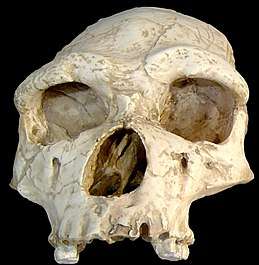
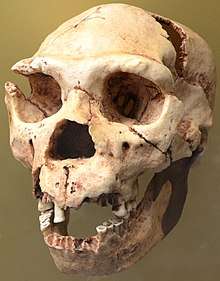
_CROP.jpg)
